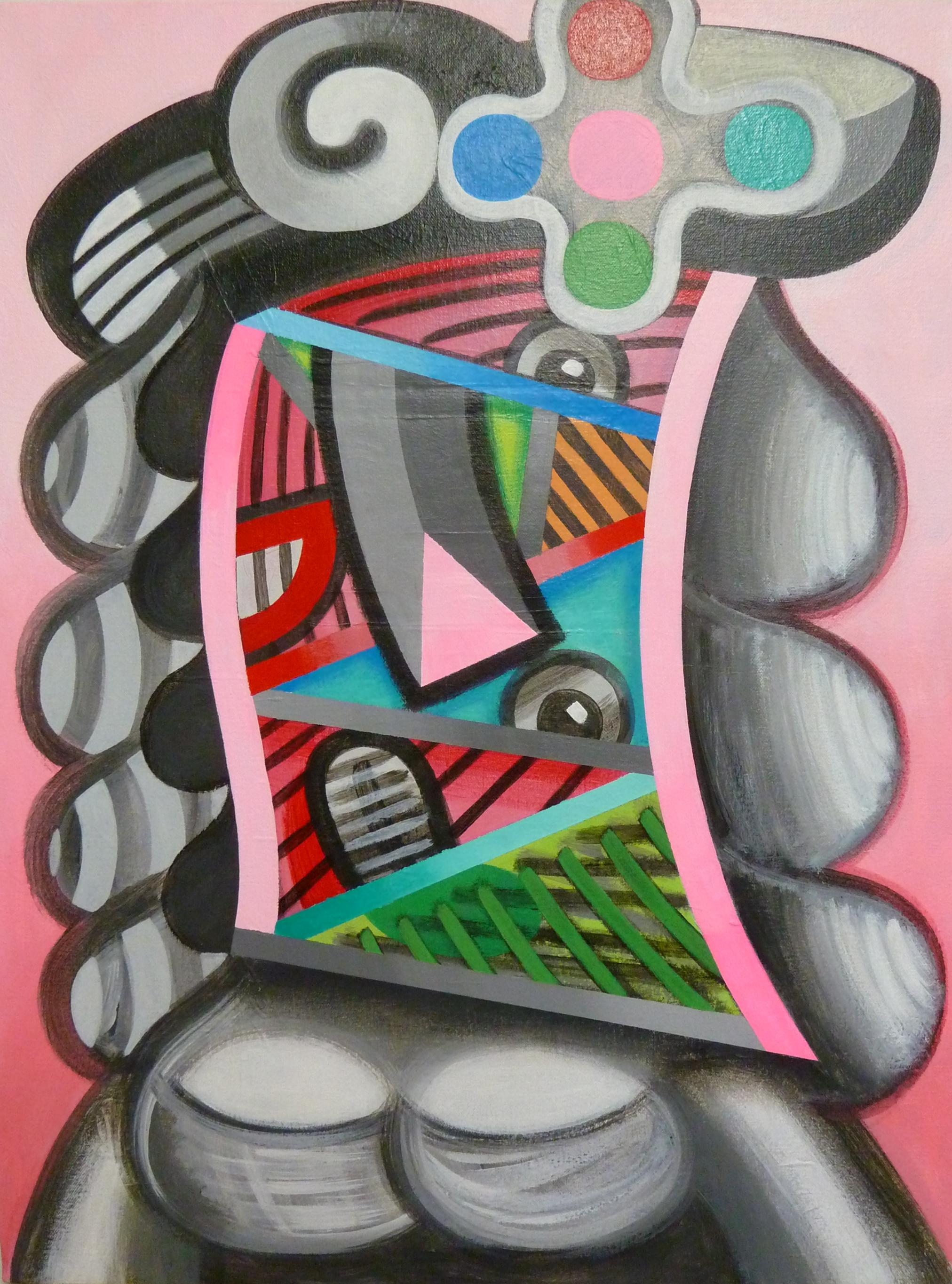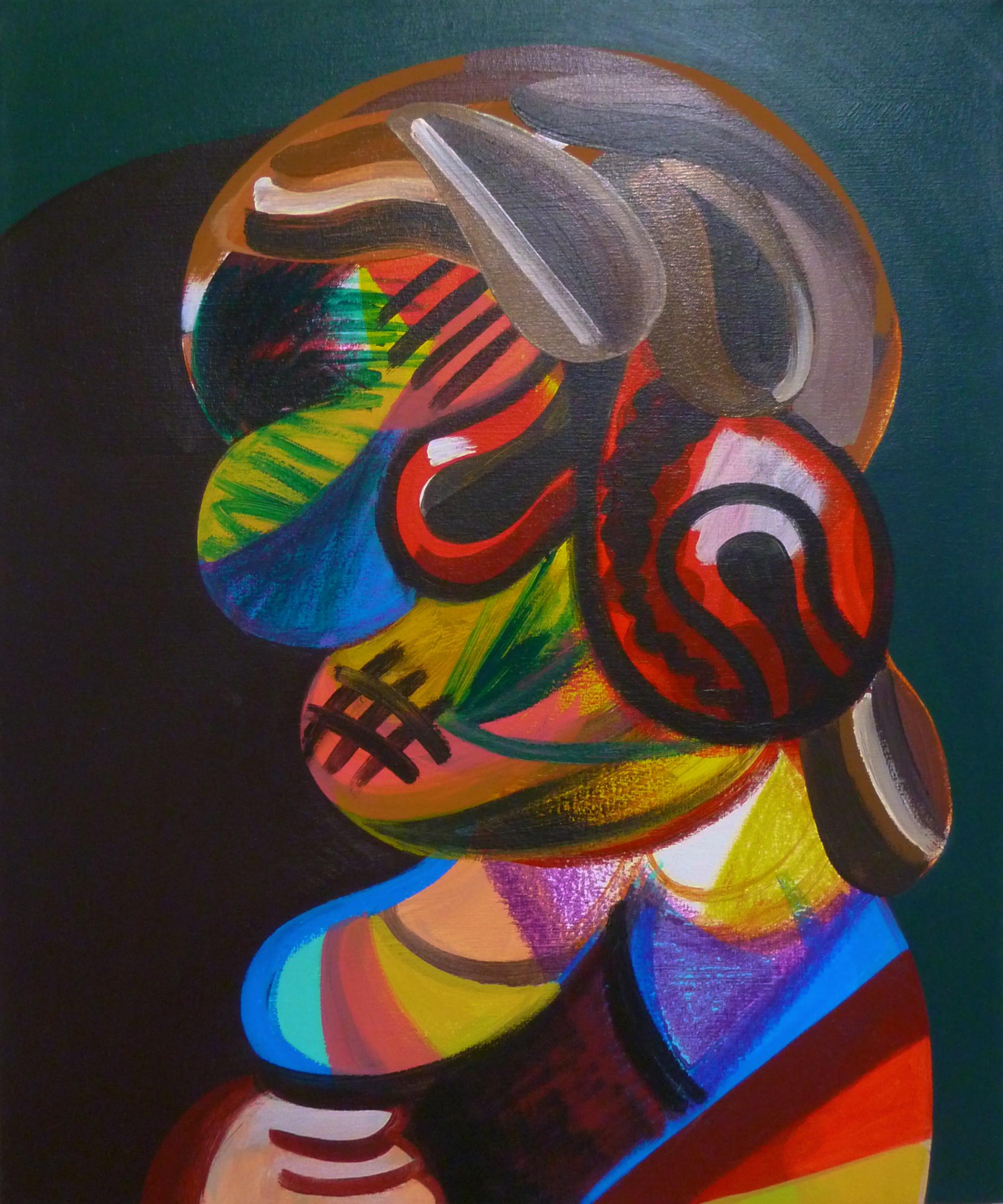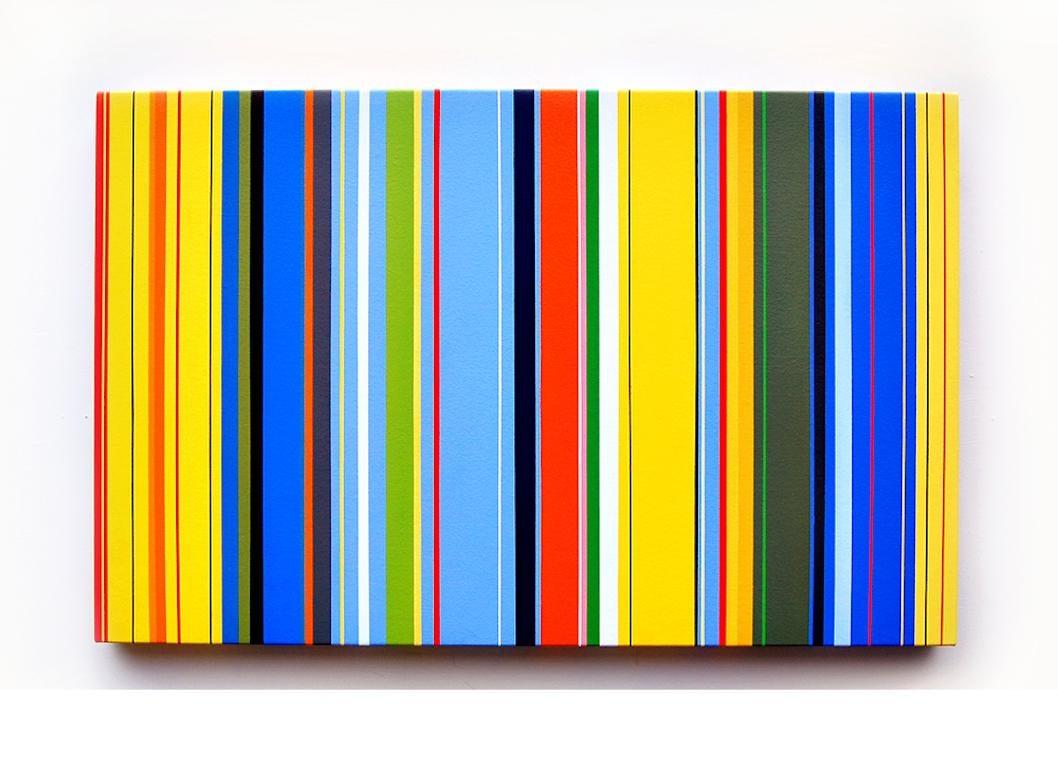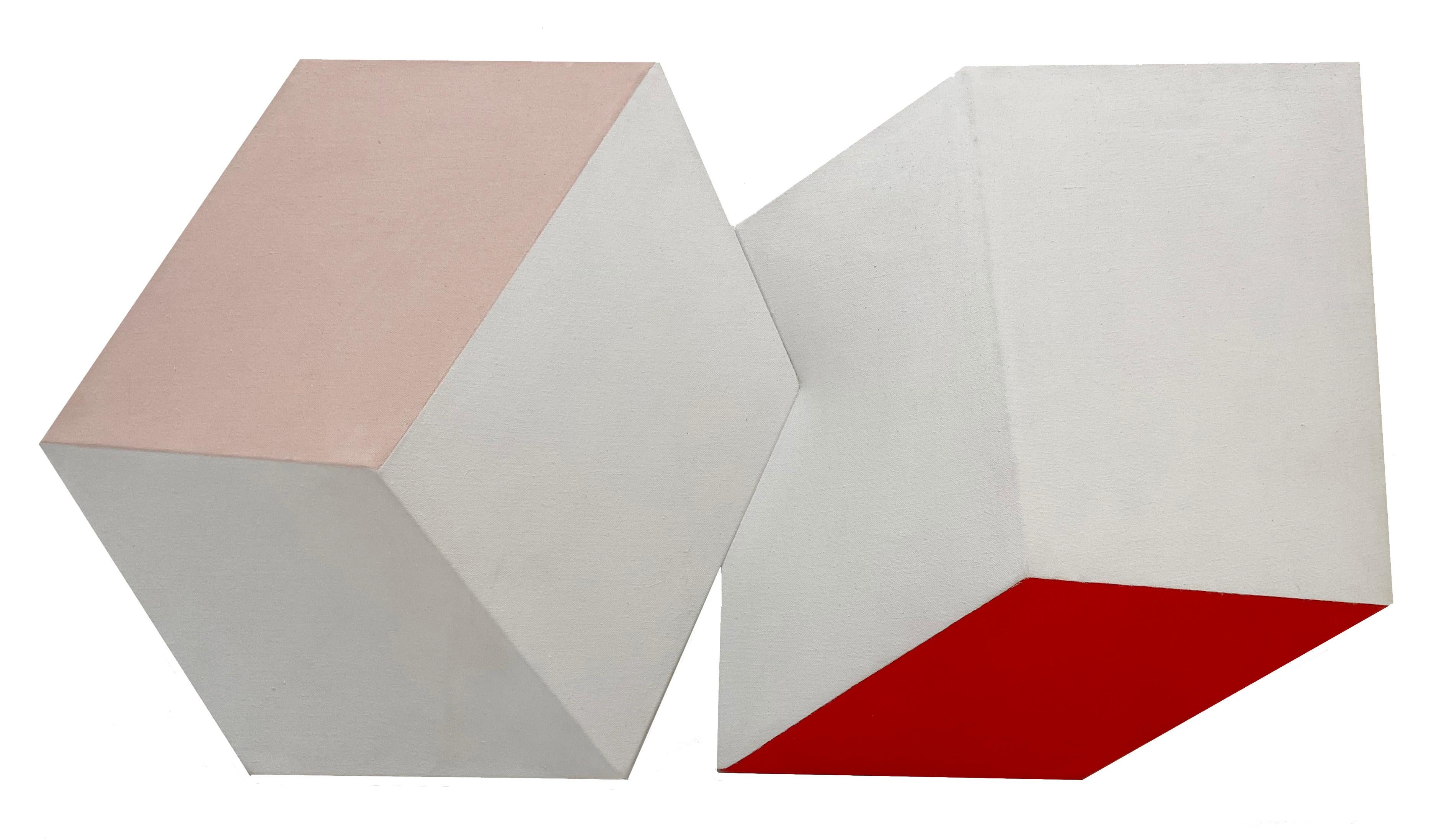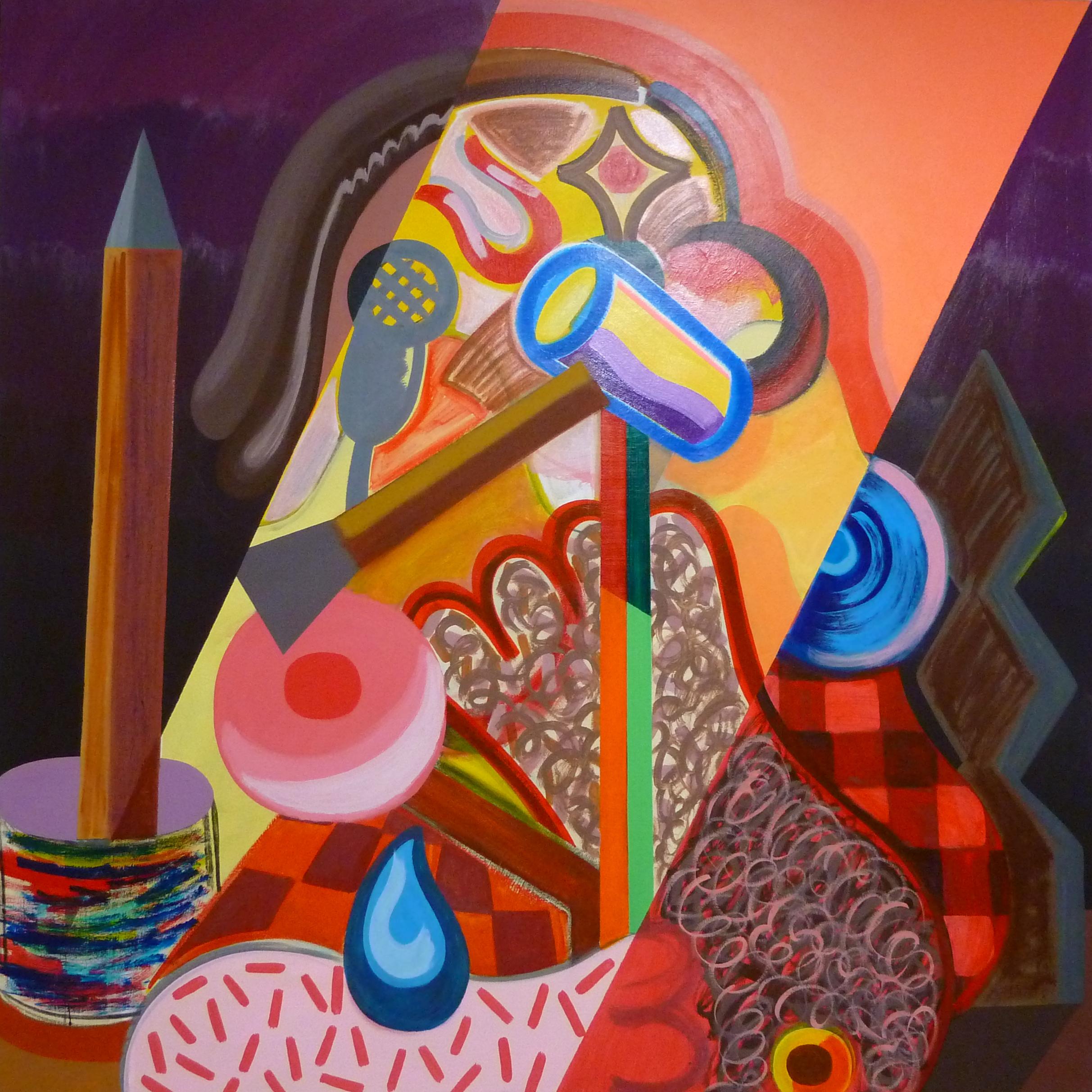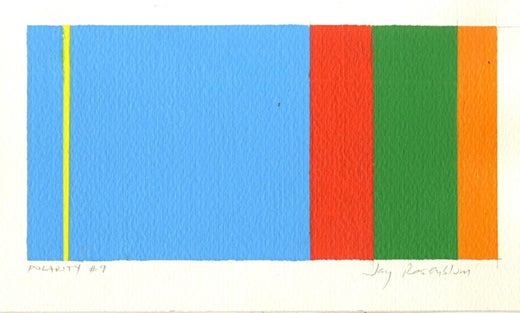Items Similar to "Untitled, " Jay Rosenblum, Hard-Edge Color Field, Colorful Horizontal Stripes
Want more images or videos?
Request additional images or videos from the seller
1 of 7
Jay Rosenblum"Untitled, " Jay Rosenblum, Hard-Edge Color Field, Colorful Horizontal Stripes1973
1973
About the Item
Jay Rosenblum (1933 - 1989)
Untitled, 1973
Acrylic on canvas
54 x 128 inches
Signed twice and dated on the reverse
Provenance:
Private Collection, Long Island
Jay Rosenblum experimented with different versions of the "Visual Stripe motif" for more than thirty years. In the 1960's he developed a "hard-edge" style with "flat curtain forms" which had a clearly defined vertical emphasis. These colors as in our example move up and down the picture plane. Space is defined by shifts in color passages. As the artist explained in his own words:
"The vertical forms in my work serve as the vehicle for color and also become a dramatic means of achieving movement and deep space. This becomes possible through a great variation in the stripe thickness and the sudden emergence or disappearance of a particular band of color when it overlaps another."
Rosenblum was an ardent violinist who played for the Seventh Army Symphony in West Germany and who was also an art teacher at the School of Visual Arts. In his art Rosenblum sought to associate his great love for chamber music sonatas with his freely evolving vertical stripes of color. Rosenblum once stated:
"When these elements engage themselves in the painting, there is a great visual excitement for me. A kinship with music, in a polyphonic sense, is very strong in that simultaneously one hears lines of "overlapping" music. In some mysterious way the composer can achieve this and it is equally mysterious and effective in painting when it happens."
In much the same way that singular notes strung together create music, individual stripes of color together can be transformed into a complete art form. He thus viewed these blocks of color almost as separate notes in a piece of music that that when brought together would be transformed into a cohesive unit, resonating with a playfulness that added interest and energy to the picture. With colors Rosenblum attempted to select ones that when juxtaposed against or near one another would become "an exciting visual discovery". He would refer to such works as "free association color development". Rosenblum executed a number of these "hard-edge" paintings which included groupings of color clusters in both vertical and diagonal motifs.
Jay Rosenblum was born in New York City in 1933. He attended the Pratt Institute in Brooklyn from 1951-53, Harvard University in the summer of 1953 and Bard College in Annandale-on-Hudson, NY 1953-1955. He received a M.F.A. from Cranbrook Academy of Art in Bloomfield Hills, MI. His paintings have appeared in numerous selected solo and group exhibitions in the USA and Italy. Rosenblum was awarded the Carlos Lopez Memorial Prize in painting from the Detroit Institute of Art in Detroit, Michigan in 1955 and the Painter of the Year Award from Larry Aldrich, Ridgefield, CT in 1970. He lived and worked in Manhattan for most of his life and sadly died in a tragic bicycle accident in 1989.
- Creator:Jay Rosenblum (1933, American)
- Creation Year:1973
- Dimensions:Height: 54 in (137.16 cm)Width: 128 in (325.12 cm)
- Medium:
- Movement & Style:
- Period:
- Condition:
- Gallery Location:New York, NY
- Reference Number:1stDibs: LU184129930852
Jay Rosenblum
Jay Rosenblum experimented with different versions of the "Visual Stripe motif" for more than thirty years. In the 1960's he developed a "hard-edge" style with "flat curtain forms" which had a clearly defined vertical emphasis. These colors as in our example move up and down the picture plane. Space is defined by shifts in color passages. As the artist explained in his own words: "The vertical forms in my work serve as the vehicle for color and also become a dramatic means of achieving movement and deep space. This becomes possible through a great variation in the stripe thickness and the sudden emergence or disappearance of a particular band of color when it overlaps another." Rosenblum was an ardent violinist who played for the Seventh Army Symphony in West Germany and who was also an art teacher at the School of Visual Arts. In his art Rosenblum sought to associate his great love for chamber music sonatas with his freely evolving vertical stripes of color. Rosenblum once stated: "When these elements engage themselves in the painting, there is a great visual excitement for me. A kinship with music, in a polyphonic sense, is very strong in that simultaneously one hears lines of "overlapping" music. In some mysterious way the composer can achieve this and it is equally mysterious and effective in painting when it happens." In much the same way that singular notes strung together create music, individual stripes of color together can be transformed into a complete art form. He thus viewed these blocks of color almost as separate notes in a piece of music that that when brought together would be transformed into a cohesive unit, resonating with a playfulness that added interest and energy to the picture. With colors Rosenblum attempted to select ones that when juxtaposed against or near one another would become "an exciting visual discovery". He would refer to such works as "free association color development". Rosenblum executed a number of these "hard-edge" paintings which included groupings of color clusters in both vertical and diagonal motifs. Jay Rosenblum was born in New York City in 1933. He attended the Pratt Institute in Brooklyn from 1951-53, Harvard University in the summer of 1953 and Bard College in Annandale-on-Hudson, NY 1953-1955. He received a M.F.A. from Cranbrook Academy of Art in Bloomfield Hills, MI. His paintings have appeared in numerous selected solo and group exhibitions in the USA and Italy. Rosenblum was awarded the Carlos Lopez Memorial Prize in painting from the Detroit Institute of Art in Detroit, Michigan in 1955 and the Painter of the Year Award from Larry Aldrich, Ridgefield, CT in 1970. He lived and worked in Manhattan for most of his life and sadly died in a tragic bicycle accident in 1989.
About the Seller
5.0
Platinum Seller
These expertly vetted sellers are 1stDibs' most experienced sellers and are rated highest by our customers.
Established in 2021
1stDibs seller since 2022
63 sales on 1stDibs
Typical response time: 1 hour
- ShippingRetrieving quote...Ships From: New York, NY
- Return PolicyA return for this item may be initiated within 3 days of delivery.
More From This SellerView All
- "The Secrets in the Circle, " Oli Sihvonen, Blue and Red Hard-Edge GeometricLocated in New York, NYOli T. Sihvonen (1921 - 1991) The Secrets in the Circle, 1962 Oil on canvas 25 x 34 in Signed lower right; signed, titled dated, and inscribed "Box 563 Taos, N.M." on the reverse Provenance: Private Collection, Nyack, New York Known for large, hard-edged abstractions, Oli T. Sihvonen, a Brooklyn native of Finnish ancestry, grew up in Connecticut. He attended the Norwich Art School before enrolling at the Art Students League in New York between 1938 and 1941. During World War II, Sihvonen served in the United States Army as a sergeant, specializing, as he later said, in “camouflage and deception.” His tour of duty took him to Europe where he encountered the work of Paul Cézanne. In the summer of 1946, Sihvonen traveled to western North Carolina to study at Black Mountain College, which experienced a boost in enrollment following the war years. He was greatly influenced by the progressive color theories of Josef Albers, and, later, the thinking of Buckminster Fuller. After leaving Black Mountain in 1948, Sihvonen continued his studies under the G.I. Bill at Louis Ribak’s Taos Valley Art School in New Mexico from 1949 to 1950. A year spent painting murals in Mexico included work for the Instituto Politécnico Nacional in Mexico City, an early example of his large-scale proficiency. Returning to the East Coast, Sihvonen held a succession of teaching posts: initially in Washington, DC, and then in New York City, first at Hunter College in 1954 and the following academic year at Cooper Union. Drawn to the southwestern landscape, Sihvonen moved to New Mexico, where he resided in Taos from 1956 through 1967. There, he painted sizeable geometric compositions with exuberant colors, which was atypical of Taos painters...Category
1960s Hard-Edge Abstract Paintings
MaterialsCanvas, Oil
- "Untitled" Sherron Francis, Female Abstract Expressionism, Red Green Color FieldBy Sherron FrancisLocated in New York, NYSherron Francis Untitled, circa 1975 Acrylic on canvas 90 x 64 inches Artists such as Helen Frankenthaler, Morris Louis, Dan Christensen, and Sam Francis are already well-known name...Category
1970s Abstract Expressionist Abstract Paintings
MaterialsCanvas, Acrylic
- "Pete's Neck", Sherron Francis, Female Abstract Expressionist, Beige Color FieldBy Sherron FrancisLocated in New York, NYSHERRON FRANCIS (AMERICAN, B. 1940) Pete's Neck, 1981 Acrylic on canvas 34 1/2 x 22 inches Signed, titled and dated on the reverse A reappraisal is lo...Category
1980s Abstract Expressionist Abstract Paintings
MaterialsCanvas, Acrylic
- "Trap Rock, " Sherron Francis, Female Abstract Expressionism, Blue Color FieldBy Sherron FrancisLocated in New York, NYSHERRON FRANCIS (AMERICAN, B. 1940) Trap Rock, 1972 Acrylic on canvas 22 3/4 x 16 inches Signed, titled and dated on the reverse A reappraisal is long overdue for the second-generation abstract expressionists. Artists such as Helen Frankenthaler, Morris Louis, Dan Christensen, and Sam Francis are already well-known names. However, Sherron Francis, a female artist from the Midwestern United States, exhibited alongside many of these stars, yet has not been the recipient of a major exhibition in nearly 40 years. Francis was born in the Chicago suburb of Downers Grove, Illinois in 1940. She studied fine art at the University of Oklahoma from 1958 to 1960 before transferring to the Kansas City Art Institute for better educational opportunities. At the time, Francis remained loyal to figurative art. Philip Pearlstein, a contemporary artist and visiting professor once remarked at the confidence of Francis’ draftsman abilities. In the early 1960s, art dealers and gallerists from New York would visit the Institute to recruit artists by offering scholarships, but they only offered these scholarships to men. Francis was forced to plead with deans to allow a scholarship for women so that she could continue her studies. She ultimately graduated from the Kansas City Art Institute in 1963. In Missouri, Francis met Dan Christensen (Class of 1964), an artist friend, who would play a key role in her career throughout the next two decades. Francis then received her MFA from the University of Indiana, where she was housemates with Mernet Larsen, before assuming a teaching position at Eastern Michigan University. In 1968, with only $300 on hand, Francis moved to 16 Waverly Place in Soho. At the time, the neighborhood boasted some of the biggest names in abstract expressionism. She quickly became friends with Peter Reginato, Walter Darby Bannard, Michael Steiner, Peter Young, Larry Zox, and Larry Poons, who all lived and worked in the neighborhood. In fact, Francis introduced Larry Poons to his now wife, Paula, a friend and student of Sherron’s. Francis helped to found The Bowery Gallery in 1969 and received her first solo exhibition there in 1970 for her figurative works. After this exhibition, Francis decided to switch to abstraction. By 1971, Christensen, who was exhibiting with Andre Emmerich, introduced Francis to the legendary gallerist. There was no better gallery to be showcasing abstract expressionism and color field painting during this decade for an artist. For example, in 1972, Emmerich held solo exhibitions by art titans, such as Hans Hofmann, Al Held, Esteban Vicente, David Hockney, and Morris Louis. In 1973 alone, Emmerich gave one-person exhibitions to Helen Frankenthaler, Kenneth Noland, Hans Hofmann, Jack Bush and a new discovery: 32-year-old Sherron Francis. The January 27 - February 14 exhibition for Francis was a great success with Peter Schjeldahl commenting in the New York Times: “Francis has…sidestepped the danger of seeming hopelessly derivative of such artists as Mark Rothko, Morris Louis and Helen Frankenthaler —by, it seems to me, the use of a single canny formal device. All her canvases are tall, vertical rectangles. What this shape achieves is a physical presence that supports the paintings' fragile play of color and texture. Bearing roughly the proportions of the human body, but bigger in size, her pictures confront the viewer with a satisfying firmness, inviting delectation.” Francis’s career now took off with the stain paintings. In a 1974 article in Arts Magazine, Whee Kim writes, “She has asserted the credibility of her own answer to the problem of the outer edge of a canvas by limiting her investigations to a singular central image. In her variations on this theme, an intuitive sense of color and touch is given restricted free-play.” Schjeldahl added, “Her paintings, stained and brushed to a suavely grainy texture, each float an area of warm, soft color in a somewhat less‐intensely colored field. The areas are amorphous in shape and closely related, by hue, to the surrounding fields. Her colors run to luxurious brown‐golds, dreamy bluegreens and dusty pinks, though each canvas is alive with a variety of evanescent hues and tints. The goal of her art is to be at once as gorgeous and as delicate as possible: she intends to ravish.” In 1973, Francis exhibited at the Whitney Biennial and then received a second solo exhibition at Emmerich the following year. Corporate collections and private enthusiasts, including Helen Frankenthaler, rushed to purchase her paintings. More than sixty of her paintings sold in one year at Emmerich’s gallery. Throughout the 1970s and early 1980s, Francis exhibited at other leading American galleries, including Janie C. Lee Gallery in Houston, Barbara Kornblatt Gallery in Baltimore, Douglas Drake in Kansas City, Rubiner Gallery in Detroit, and Tibor de Nagy Gallery in New York. Francis always marched to the beat to her own drum. Although she admired the works of Jules Olitski, Jack Bush, and Kenneth Noland, Francis never felt that her work and lifestyle were influenced by others. When her friends summered in the...Category
1970s Abstract Expressionist Abstract Paintings
MaterialsCanvas, Acrylic
- "Untitled" Sherron Francis, Female Abstract Expressionism, Black Color FieldBy Sherron FrancisLocated in New York, NYSherron Francis Untitled, 1973 Acrylic on canvas 70 x 48 inches Artists such as Helen Frankenthaler, Morris Louis, Dan Christensen, and Sam Francis are already well-known names. How...Category
1970s Abstract Expressionist Abstract Paintings
MaterialsCanvas, Acrylic
- "Untitled, " Knox Martin, Abstract ExpressionismBy Knox MartinLocated in New York, NYKnox Martin (1923 - 2022) Untitled Signed to lower edge Acrylic and gold foil on canvas 9 x 9 inches Knox Martin (1923-2022) was an esteemed New York School painter. Knox Martin was born in 1923 in Barranquilla, Colombia. He was the son of the aviator, painter, and poet William Knox Martin, the first man to fly over the Andes Mountains. After serving in World War II, Knox Martin attended the Art Students League of New York on the G.I. Bill from 1946-1950, where he studied with Harry Sternberg, Vaclav Vytlacil, Will Barnet, and Morris Kantor. In 1954, Knox Martin's friend Franz Kline placed a painting of his in the Stable Gallery Annual. Charles Egan of the renowned Charles Egan Gallery saw Knox Martin's painting at the Stable Gallery and asked Martin to show his work in a one-man show for the tenth anniversary of the Egan Gallery. Since then, Knox Martin was a celebrated painter, sculptor and muralist. Knox Martin had an extensive exhibition record and his work is in museum, corporate and private collections worldwide. His two best-known murals in NYC are Venus and Woman with Bicycle...Category
Late 20th Century Abstract Abstract Paintings
MaterialsGold, Foil
You May Also Like
- "Woman in Pink, Blue, and Gray", acrylic painting, cubist portrait, classic poseLocated in Toronto, Ontario"Woman in Pink, Blue, and Gray" is an acrylic on canvas painting measuring 24" tall by 18" wide. It's very active, with a woman wearing a colorful cap with feather, her tresses falling down behind/beside her, portrayed with cubist abandon as the artist folds in Picasso with Philip Guston... Note all the formal elements are present – her eyes, her smile, her dress and bosom – yet assemble and disassemble in front of our eyes. From Peter Schenck...Category
21st Century and Contemporary Hard-Edge Portrait Paintings
MaterialsCanvas, Acrylic
- "Rembrandt Woman", acrylic painting, portrait, abstract, cubism, classic poseLocated in Toronto, Ontario"Rembrandt Woman" is an intriguing painting, a woman in classic Dutch master portrait pose with a hand modestly holding her secrets dear, yet por...Category
21st Century and Contemporary Hard-Edge Portrait Paintings
MaterialsCanvas, Acrylic
- The Katydids Rush Me (vibrant stripes painting hard edge modern colourful green)By Kurt HerrmannLocated in Quebec, QuebecAbout the series COLOR BOMBS I want the Color Bombs to be beacons of positivity that can radiate across the room or whisper quietly beside you. I love the freedom and openness of co...Category
2010s Hard-Edge Abstract Paintings
MaterialsCanvas, Acrylic, Wood Panel
- Lunar Crickets (vibrant stripes painting hard edge modern yellow lines blue)By Kurt HerrmannLocated in Quebec, QuebecAbout the series COLOR BOMBS I want the Color Bombs to be beacons of positivity that can radiate across the room or whisper quietly beside you. I love the freedom and openness of co...Category
2010s Hard-Edge Abstract Paintings
MaterialsCanvas, Acrylic, Wood Panel
- CubesBy Charles HinmanLocated in Greenwich, CTOur shaped canvas which also is a sculptural form in essence for a wall, is a geometric play of optical illusion. Hinman is an important pioneer of exploration in the contemporary world, away from the idea of the “square” and flat canvas. He is linked to such artists as Robert Indiana, James Rosenquist, Tom Wesselman and he pre-dated Frank Stella’s exploration of canvas as wall relief structures...Category
1970s Hard-Edge Abstract Paintings
MaterialsCanvas, Acrylic
- "Strengths and Weaknesses", acrylic, charcoal, art history, abstract, portraitLocated in Toronto, Ontario"Strengths and Weaknesses" is a portrait exploring several elements and strategies that fascinate the artist – notably the performance anxiety induced by simply being an artist, staring down the freight train of art history as it hurtles toward you every time you pick up a brush. Luck? Talent? Maybe. There are signposts and guides in this painting, of course (Cubism! Surrealism! Brancusi! Guston!), but they can clobber you too if you're not careful. Even the phrase "strengths and weaknesses" smacks of compromises and rationalization – deadly to an artist looking to construct their own integral world. "Strengths and Weaknesses" is an acrylic and charcoal on canvas measuring 54" tall by 54" wide. It was included in the artist's solo show "Comedy Cellar" at Freight + Volume Gallery, New York City in July 2018. (See last photograph for an installation view.) From Daniel Gerwin – "Schenck’s color is vibrant, wild, saturated to the point of overheating, and altogether brilliant in the balancing of hues, temperatures, shapes, and color quantities. The paintings have a remarkable coherence for their dizzying juxtaposition of so many small chromatic passages." (Essay: The Anxiety and the Ecstasy) Peter Schenck...Category
21st Century and Contemporary Hard-Edge Still-life Paintings
MaterialsCharcoal, Acrylic, Canvas
